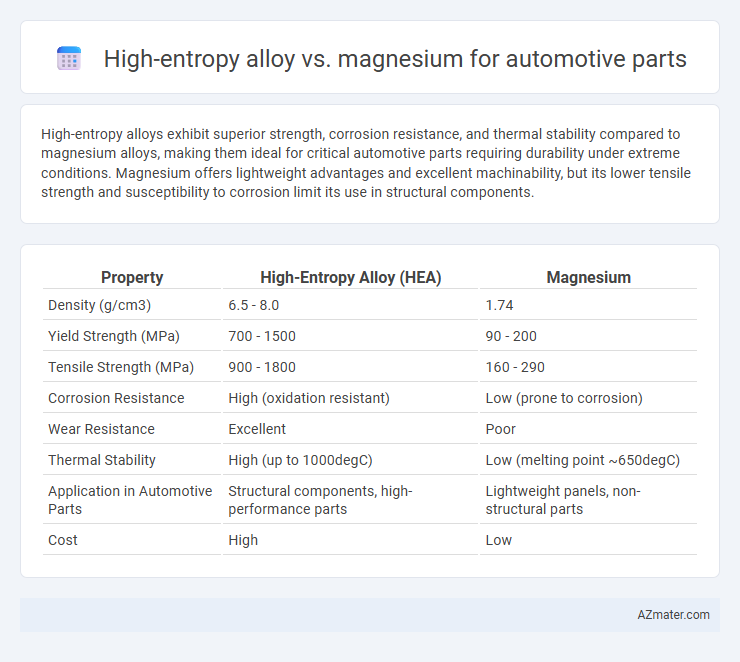High-entropy alloys exhibit superior strength, corrosion resistance, and thermal stability compared to magnesium alloys, making them ideal for critical automotive parts requiring durability under extreme conditions. Magnesium offers lightweight advantages and excellent machinability, but its lower tensile strength and susceptibility to corrosion limit its use in structural components.
Table of Comparison
| Property | High-Entropy Alloy (HEA) | Magnesium |
|---|---|---|
| Density (g/cm3) | 6.5 - 8.0 | 1.74 |
| Yield Strength (MPa) | 700 - 1500 | 90 - 200 |
| Tensile Strength (MPa) | 900 - 1800 | 160 - 290 |
| Corrosion Resistance | High (oxidation resistant) | Low (prone to corrosion) |
| Wear Resistance | Excellent | Poor |
| Thermal Stability | High (up to 1000degC) | Low (melting point ~650degC) |
| Application in Automotive Parts | Structural components, high-performance parts | Lightweight panels, non-structural parts |
| Cost | High | Low |
Overview of High-Entropy Alloys and Magnesium in Automotive Applications
High-entropy alloys (HEAs), characterized by multiple principal elements forming a single solid solution, exhibit exceptional mechanical strength, corrosion resistance, and thermal stability, making them suitable for high-performance automotive parts such as engine components and brake systems. Magnesium alloys are prized for their low density and high specific strength, significantly reducing vehicle weight to improve fuel efficiency and decrease emissions in applications like chassis and body panels. While HEAs offer superior durability and wear resistance, magnesium alloys provide cost-effective lightweight solutions, driving innovation in automotive material engineering.
Material Properties Comparison: High-Entropy Alloys vs Magnesium
High-entropy alloys (HEAs) exhibit exceptional mechanical strength, corrosion resistance, and thermal stability compared to magnesium alloys, which are valued for their lightweight and excellent machinability. HEAs typically offer higher wear resistance and structural integrity at elevated temperatures, making them suitable for critical automotive components subjected to stress and heat. Magnesium alloys provide superior weight reduction benefits, essential for fuel efficiency, but often require surface treatments to enhance durability and corrosion protection.
Mechanical Strength and Durability Analysis
High-entropy alloys (HEAs) exhibit superior mechanical strength and enhanced durability compared to magnesium alloys, making them promising candidates for automotive parts subjected to high stress and wear. HEAs maintain excellent tensile strength and fatigue resistance at elevated temperatures, outperforming magnesium's lower strength-to-weight ratio and susceptibility to corrosion. Their complex microstructures contribute to improved hardness and resistance to mechanical deformation, extending the service life of critical automotive components.
Weight Reduction Potential in Automotive Design
High-entropy alloys (HEAs) offer superior strength-to-weight ratios compared to traditional materials, making them ideal for automotive parts aiming for weight reduction. Magnesium, known for its low density (1.74 g/cm3), provides significant weight savings over conventional steels but often lacks the mechanical robustness of HEAs under high-stress conditions. Integrating HEAs in automotive design can enhance structural performance while reducing overall vehicle weight more effectively than magnesium alone, promoting improved fuel efficiency and emissions reduction.
Corrosion Resistance: High-Entropy Alloy vs Magnesium
High-entropy alloys (HEAs) exhibit superior corrosion resistance compared to magnesium due to their complex multi-element composition, which forms stable passive oxide layers that protect against aggressive automotive environments. Magnesium alloys, while lightweight, are prone to rapid corrosion, especially in saltwater and humid conditions, leading to reduced durability in automotive parts. The enhanced corrosion resistance of HEAs translates to longer component lifespan and lower maintenance costs in automotive applications requiring robust performance.
Manufacturing and Processing Challenges
High-entropy alloys (HEAs) present significant manufacturing challenges for automotive parts due to their complex multi-element composition, requiring precise control over melting, solidification, and homogenization processes to achieve uniform microstructures. In contrast, magnesium alloys, known for their low density and ease of casting, face issues such as susceptibility to oxidation and difficulty in achieving consistent mechanical properties during die casting and extrusion. Both materials demand specialized processing techniques, but HEAs require advanced thermal management and alloy design optimization to overcome manufacturing hurdles at scale.
Cost Analysis and Market Availability
High-entropy alloys (HEAs) offer superior mechanical properties and corrosion resistance compared to magnesium but come with significantly higher production costs due to complex manufacturing processes and expensive raw materials. Magnesium is widely available and favored in automotive applications for its lightweight and cost-effectiveness, with well-established supply chains driving affordability in mass production. Market availability favors magnesium alloys benefiting from extensive industrial use, whereas high-entropy alloys remain niche, limiting their current economic competitiveness despite promising performance advantages.
Sustainability and Environmental Impact
High-entropy alloys exhibit superior mechanical strength and corrosion resistance compared to magnesium, enabling longer-lasting automotive parts and reducing the frequency of replacements, which supports sustainability goals. Magnesium, while lighter and highly recyclable, often faces challenges like lower durability and higher energy consumption during alloy production, impacting its overall environmental footprint. Choosing high-entropy alloys for critical automotive components can minimize lifecycle environmental impact through enhanced durability and improved resource efficiency.
Case Studies: Real-World Automotive Applications
High-entropy alloys (HEAs) demonstrate superior mechanical strength, corrosion resistance, and thermal stability compared to magnesium when applied to automotive parts, as evidenced by case studies involving engine components and structural assemblies. Real-world applications show HEAs extending component lifespan and reducing maintenance through enhanced wear resistance, while magnesium offers weight reduction benefits but faces challenges with durability and environmental degradation. Data from automotive manufacturers reveal that HEA incorporation results in improved fuel efficiency and safety metrics due to the material's optimized strength-to-weight ratio and performance under stress.
Future Trends and Innovation in Automotive Materials
High-entropy alloys (HEAs) offer superior strength-to-weight ratios and corrosion resistance compared to conventional magnesium alloys, making them promising for lightweight automotive components that enhance fuel efficiency and durability. Future trends in automotive materials emphasize integrating HEAs with additive manufacturing to optimize complex part geometries and performance characteristics. Innovations focus on tailoring HEA compositions for enhanced wear resistance and thermal stability, addressing the demanding conditions in electric vehicle powertrains and lightweight structural applications.

Infographic: High-entropy alloy vs Magnesium for Automotive Part
 azmater.com
azmater.com